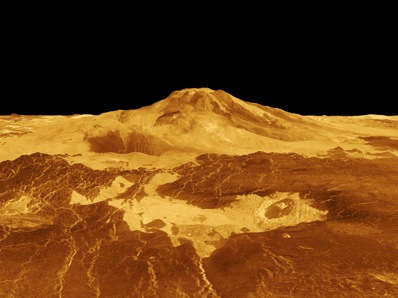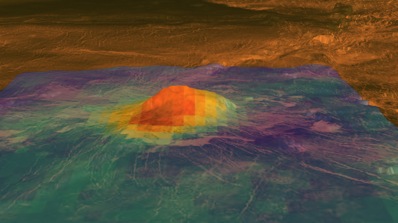


|

|
 |
|
Venus is alive! DR EMILY BALDWIN ASTRONOMY NOW Posted: 9 April ESA's Venus Express mission has detected clear evidence for relatively young lava flows on our neighbouring planet, suggesting that Venus may still be active today.  Lava flows extend for hundreds of kilometres across the plains around eight kilometre high Maat Mons. Image: NASA/JPL. Lava flows extend for hundreds of kilometres across the plains around eight kilometre high Maat Mons. Image: NASA/JPL.
Scientists have long believed that beneath Venus' thick atmosphere lava once dominated and shaped the landscape; its lack of impact craters compared with other solid bodies in the Solar System a clear indicator that something has smoothed over its surface. But how fast this resurfacing took place – that is, one cataclysmic resurfacing episode or a series of small volcanic eruptions – had, until now, remained a mystery. "Previous spacecraft gave us hints of volcanic activity, but we didn't know how long ago that occurred," says Sue Smrekar of NASA's Jet Propulsion Laboratory and lead author of the paper describing the work. "Now we have strong evidence right at the surface for recent eruptions." Of course in geological terms 'recent' could mean within the last several million years, but Joern Helbert and Nils Mueller from the DLR Institute of Planetary Research speculate that the majority of the lava flows studied in this project are "probably younger than 250,000 years, which in geological terms, means that they are practically from the present day."  Heat patterns derived from VIRTIS and married up with topography data from the Magellan spacecraft shows that hotspots, which resemble those in Hawaii, are located over underground magma chambers that may still be active today. In this illustration of the volcanic peak of Iduun Mons the warmest area, shown in red to orange, is centred on the summit. Image: NASA/JPL/ESA. Heat patterns derived from VIRTIS and married up with topography data from the Magellan spacecraft shows that hotspots, which resemble those in Hawaii, are located over underground magma chambers that may still be active today. In this illustration of the volcanic peak of Iduun Mons the warmest area, shown in red to orange, is centred on the summit. Image: NASA/JPL/ESA.
The team used the Visible and Infrared Thermal Imaging Spectrometer (VIRTIS) on Venus Express to study the way different volcanic regions emit infrared radiation, or heat, and found that they had different characteristics, that is, a higher emissivity, than their surrounding areas. This finding suggests the regions have different compositions, and is interpreted as evidence of a lack of surface weathering on the lava flows, indicating that they erupted relatively recently. VIRTIS data analysed last year revealed that certain areas deviate from predicted temperatures by several degrees, a possible indicator of different types of rock which have different thermal properties (read our report here). Further work will be required to determine just exactly what the materials are that are responsible for emitting the radiation detected by Venus Express. Published in this week's edition of the journal Science, the new data will help scientists determine how the interior of the planet works, how gasses emitted during the eruptions influence the planet's climate, and ultimately, how and when Venus and the Earth evolved so differently. "Perhaps Venus can tell us why Earth is so special," adds Helbert. |
|
|
|
|